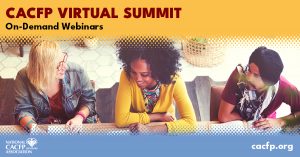Posts Tagged ‘learning center’
Reduce Findings: Make Paperwork a Priority ($)
Get step-by-step guidance on how to maximize policies, procedures and training to counteract the most common findings. Take home handouts on how to strengthen your business by targeting the inefficiencies in your workflow.
Read MoreUS Poverty & Its Impact on Children ($)
Learn about the root causes of poverty, understand how poverty impacts families and children, and explore policy ideas and strategies for reducing poverty and mitigating its negative effects.
Read MoreOunce Equivalents for Grains: No Weigh!
Team Nutrition has several resources and tools to help CACFP operators transition to grains ounce equivalents – no food scales required! Receive hands-on training and leave with a menu of options for successful implementation. Download the Food Buying Guide (FBG) before watching this session.
Read MoreAll About Policy
Emergency funding, child nutrition reauthorization, policy waivers and more! Hear what’s going on nationally and how it could affect you locally.
Read MoreStandardizing Recipes ($)
Standardized recipes are a critical tool to scratch cooking in the CACFP. This session focuses on some key concepts that are essential to understanding, developing, and serving standardized recipes to meet desired meal pattern contributions. This results in consistent product yields, reducing food costs, and efficiency in the kitchen. Learn how to create standardized recipes for your centers and how to guide your home providers so they can be sure their recipes are #CACFPCreditable.
Read MoreMaking Multiple Meals from Just a Few Ingredients ($)
Variety is the spice of life! However, adding variety to your menu while managing a budget, food waste, storage space and more can be a real challenge in a food and nutrition program. Ease some of these issues by learning how to menu plan using multipurpose menu products. We’ll share successful menu planning techniques, tips and tricks, and chef-led demos.
Read MoreCOVID Challenges & Opportunities in the CACFP ($)
Learn about the impact of COVID on CACFP providers, sponsors, and state agencies as told through the results of a nationwide survey. Hear about the challenges and training needs for operators, get insights from state directors about challenges of administering CACFP during COVID, and learn about strategies that states and the federal government can take to better support families with young children to avoid food insecurity, including CACFP-specific infrastructure and support.
Read MoreCost-Saving Strategies for Sponsors ($)
Learn about proven strategies that have resulted in significant cost savings for CACFP and SFSP Sponsors including electronic meal counting, leftover policies, frozen meals, shelf-stable back-up meals, different meal packaging, and partnering with food banks for donated foods. These valuable tools and tips can produce savings that translate into better quality food and financial security for programming.
Read MoreBaby Steps: Ounce Equivalents for Grains and Infants
Get ready to use ounce equivalents to determine the amount of grains to serve to infants in the CACFP! Learn about the requirement going into effect on October 1, 2021 and tools that make implementation easier. Participants will leave this session knowing how much cereal, crackers, and bread are needed to meet meal pattern requirements for infants.
Read MoreUSDA National Breastfeeding Promotion and Support Campaign for Millennial WIC Moms
Get an overview of USDA’s campaign, which supports breastfeeding moms with comprehensive, current and culturally appropriate messaging, materials, and a website. Campaign goals encourage initiation and continuation of breastfeeding; increase knowledge and ability to breastfeed; increase referrals to WIC; and provide technical assistance in the promotion of breastfeeding.
Read More

